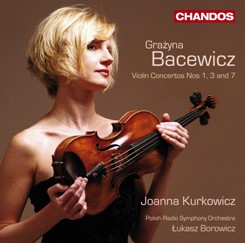Grazyna Bacewicz - Violin Concertos Nos.1,3,7 (2009)
Grazyna Bacewicz - Violin Concertos Nos.1,3,7 (2009)

01. Violin Concerto No. 7 - I. Tempo di mutabile [0:07:57.58] 02. II. Largo [0:08:28.41] 03. III. Allegro [0:05:41.09] 04. Violin Concerto No. 3 - I. Allegro molto moderato [0:08:26.09] 05. II. Andante [0:07:33.10] 06. III. Vivo [0:07:18.66] 07. Violin Concerto No. 1 - I. Allegro [0:04:09.70] 08. II. Andante (molto espressivo) [0:04:42.72] 09. III. Vivace [0:03:35.61] 10. Overture [0:05:53.96] Joanna Kurkowicz – violin Polish Radio Symphony Orchestra Lukasz Borowicz – conductor
Chandos certainly hedged its bets right when it came to programming its second release with Polish violinist Joanna Kurkowicz; although they are well known and popular in former Eastern bloc countries, the violin concertos of Polish composer Grazyna Bacewicz have never been circulated on recordings in the West. The Concerto No. 7 (1965) -- Bacewicz's last work in the genre -- is particularly well liked in Poland and is presented upfront on Chandos' Grazyna Bacewicz: Violin Concertos 1, 3, and 7. Bacewicz's Seventh Violin Concerto was written in 1965 as a sort of response to international serialism; while she was certainly in favor of composers enjoying a free voice within the politically constrained society in which she lived, Bacewicz wasn't crazy about the idea of formalized music and stated as much in her writings. To describe the Concerto No. 7 as being "free atonal" is to not really get it right; it's full of eerie special effects and surprises, although it can be said that Bacewicz develops the material out of related kinds of harmonic fields. However, the orchestral ripieno is used very sparingly; the springboard of the harmonic fields themselves begins with the violin solo part, and the violin's resources become the basis for what the whole orchestra does. No wonder this concerto has become a contemporary music evergreen; it is fantastic, visionary, exciting, and belongs to its own special musical universe.
The other two concertos are far more conventional than the seventh, but the common thread is that the violinist is at the center of the action. The Violin Concerto No. 1 (1937) and Violin Concerto No. 3 (1948) were written for Bacewicz herself to play; the earlier concerto is a little more attuned to neo-classicism and French style, whereas folk motifs dominate the later one, and they are both very beautiful and technically assured concerti. As a bonus, conductor Lukasz Borowicz leads the Polish Radio Symphony Orchestra through a sparkling Overture (1943) of Bacewicz that borrows the "V for Victory" motif and spins it through a dazzling texture of folk-like fiddling, something that is both a response to the Second World War and a hopeful expression for its conclusion.
Kurkowicz -- who has recorded Bacewicz well before for Chandos -- is completely on top of this literature, and the Polish Radio Symphony plays with authority and gusto. The recording is typical for Chandos in that the quiet parts are a little too quiet and the loud a bit too loud, but it is clear and the violin is front and center, and that is where one would want it to be. --- Uncle Dave Lewis, allmusic.com
download (mp3 @320 kbs):
yandex mega mediafire ulozto gett
Zmieniony (Poniedziałek, 03 Wrzesień 2018 21:13)








